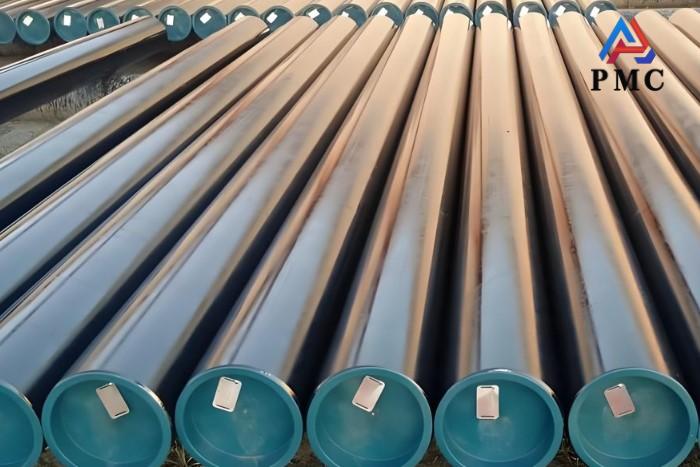
ATSM A53 Pipe vs API 5L Pipe
Steel pipes are essential in industries such as construction, water supply, and oil and gas transportation. Among the many pipe standards, ASTM A53 and API 5L are two of the most widely used specifications. While they may appear similar in form, they are designed for different purposes and performance requirements.
Overview of astm a53 pipe
ASTM A53 is a standard specification established by ASTM International for seamless and welded black and hot-dipped galvanized steel pipes. It covers nominal (average) wall thickness pipes used for mechanical, pressure, and ordinary uses in steam, water, gas, and air lines. Because of its versatility and reliable performance, ASTM A53 is one of the most commonly used carbon steel pipe standards in construction and industrial applications.
Product Types
ASTM A53 pipes are available in three types and two grades:
Type F: Furnace-butt welded (Grade A only)
Type E: Electric-resistance welded (Grades A and B)
Type S: Seamless (Grades A and B)
Grade B pipes have higher mechanical strength than Grade A and are more widely used in demanding environments.

Overview of api 5l pipe
API 5L is a specification developed by the American Petroleum Institute (API) that covers seamless steel pipes and welded steel pipes used for the transportation of oil, gas, and water in the petroleum and natural gas industries. It provides detailed requirements for material, manufacturing, testing, and quality control to ensure the pipes can perform reliably under high-pressure, long-distance, and harsh service conditions.
Product Range
API 5L pipes are produced in two Product Specification Levels (PSL):
PSL1: Basic quality level suitable for standard line pipe applications.
PSL2: Higher specification level with stricter chemical, mechanical, and testing requirements for critical pipeline service.
Comparison of key differences
The following table synthesizes the core technical indicators and application characteristics of the two standards:
Table 1: Comparison of ASTM A53 and API 5L Technical Parameters
|
Projects |
ASTM A53 |
API 5L |
|
OD Range |
21.3-762 mm |
10-762 mm |
|
Wall Thickness |
2.0-140 mm |
2-50 mm |
|
Standard Length |
6 m (common) |
6-12.2 m (customized 0.5 m) |
|
Steel Grade |
Grade A, Grade B |
Gr. B, X42, X46, X52, X60, X70, etc. |
|
Main Materials |
Carbon steel (e.g. 20#) |
Carbon to low alloy steel (with Mn, microalloys) |
Table 2: Comparison of Application Characteristics and Performance Requirements
|
Dimension |
ASTM A53 |
API 5L |
|
Core Uses |
Building Structures/Low Pressure Fluids/Mechanical Components |
Oil and Gas Long Distance Pipelines |
|
Media Types |
Water, Steam, Air |
Crude Oil, Natural Gas, CO₂ and other high risk media |
|
Environmental Requirements |
Temperature ≤ 350°C, non-corrosive environments |
High-pressure, low-temperature, corrosive geologic/marine environments |
|
Key Properties |
Weldability, machinability |
Burst resistance, low temperature toughness, corrosion resistance |
|
Industry Certification |
Conventional Pressure Vessel Certification |
Mandatory API 5L Certification + PSL1/PSL2 Classification |
How to choose?
Preferred Applications for API 5L:
API 5L pipes are best suited for pipeline systems that transport oil and gas under high pressure (above 10 MPa) or in challenging environments, such as low temperatures (below -30°C) or corrosive conditions. They are especially preferred for pipelines that need to be buried underground, laid across the sea, or routed through seismic zones, where strength, toughness, and reliability are critical.
Preferred Applications for ASTM A53:
ASTM A53 pipes are ideal for low-pressure vapor lines, building support structures, non-hazardous chemical plant piping, and other general-purpose applications. They are commonly chosen for projects that prioritize cost efficiency, ease of fabrication, and moderate mechanical requirements.
Conclusion
ASTM A53 pipe and API 5L pipe both play important roles in the industrial field, and each has unique performance characteristics and applicable scenarios. ASTM A53 pipe, with its excellent overall performance, wide range of applications, and low cost, is an ideal choice for many low-pressure transportation and general industrial applications. API 5L pipe, with its superior strength, excellent corrosion resistance, and strict quality standards, plays an irreplaceable role in specialized fields such as oil and gas transportation.
In actual projects, we must have a deep understanding of the project requirements and comprehensively consider multiple factors such as strength, technical parameters
, application characteristics, and performance requirements in order to make scientific and reasonable choices, so that each pipeline material can maximize its value in its most suitable field and provide solid and reliable guarantees for industrial development and infrastructure construction.
- 【Prev】 : ERW Pipe vs Spiral Pipe
- 【Next】 : Material Re-inspection of SMLS Pipe


